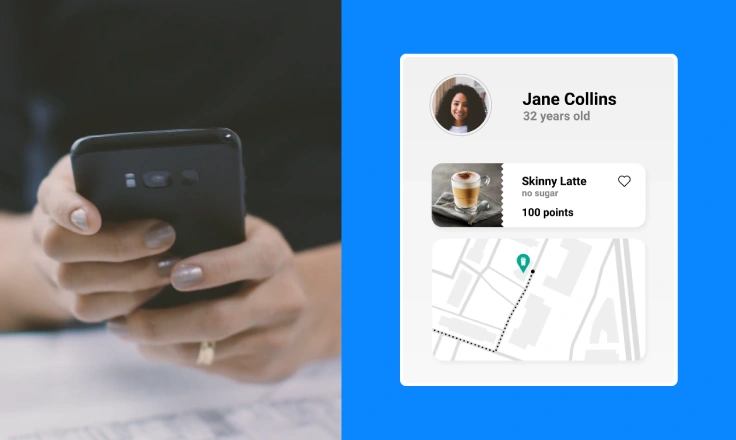AI-Driven Propensity Modeling to Predict Next Purchase and Boost Customer Loyalty
- Published
- 5 min reading
For large companies, retaining customers is crucial for sustained growth and profitability. For smaller entities, it's often a matter of survival. However, with countless alternatives at customers' fingertips, maintaining loyalty is challenging.
Artificial intelligence (AI) offers a promising solution. Its ability to process vast amounts of data rapidly and identify patterns can revolutionize how businesses understand and engage with customers. Propensity modeling, an AI-driven technique, can be a powerful tool to help your company win the battle for customer loyalty.
Keep reading to discover how propensity modeling can:
- Define customer behavior
- Boost customer loyalty
- Predict future actions
- Drive real-world business results
What is Propensity Modeling?
AI-powered propensity modeling allows businesses to predict the likelihood of customers taking a desired action. In simpler terms, propensity to buy is a statistical approach that analyzes customer data to estimate the probability of them making a future purchase.
By understanding a customer's propensity to purchase, businesses can create targeted marketing campaigns, personalized offers, and loyalty programs. It’s like knowing exactly when your customers are likely to churn and stop using your service so you can prioritize efforts to retain them. Conversely, identifying customers with high purchase potential allows you to focus marketing resources on those most likely to convert.
Let’s take a better look at the elements of a propensity model:
- Data Collection and Preprocessing: The foundation of any good model is robust data. This means information such as purchase history, demographics, browsing behavior, and interactions with marketing campaigns.
- Key Metrics and Variables Used in Models: Demographic data like age, income, and location can be combined with purchase history metrics like frequency and amount spent. Behavioral variables such as website visits, time spent on specific products, and abandoned carts further enrich the model.
- Techniques and Algorithms: Machine learning algorithms analyze the data to identify patterns and relationships between customer attributes and the desired action (e.g., next purchase). Popular techniques include logistic regression, decision trees, and neural networks.

Importance of Predicting Customer Behavior
Predictive analytics offers insights into marketing strategies. Predicting customer behavior involves employing statistical models and machine learning algorithms to identify patterns in historical data and forecast future events. A propensity to buy model can help businesses identify customers most likely to make a purchase, enabling targeted marketing campaigns and increased sales.
Predicting the next purchase is a specific application of predictive analytics that has the potential to drive sales and enhance customer satisfaction. Accurately anticipating what customers will buy next can lead companies to optimize inventory management, personalized marketing campaigns, and more relevant product recommendations.

3 Techniques for Next Purchase Prediction
- Collaborative Filtering: This method recommends products to users based on similarities with other users' preferences and purchase histories. For example, if users A and B have purchased similar items, the system might recommend items purchased by B to A.
- Sequential Recommendation Algorithms: These algorithms analyze the sequence of products purchased by a customer to predict their next likely purchase. For instance, if a customer frequently buys bread and then milk, the system might suggest butter as the next item.
- Time Series Analysis: This technique involves analyzing historical data over time to identify patterns and trends. By examining past purchase behavior, businesses can forecast future purchases, considering factors such as seasonality and product lifecycle.
Predicting the Next Purchase with AI
Imagine being able to anticipate a customer's next purchase within five days or, even more impressively, accurately predict the exact items that will fill their shopping cart. You can either patiently await the customer's return or proactively demonstrate your attentiveness by sending a personalized push notification inviting them to enjoy their favorite morning coffee.

The Next Purchase (NTP) model is an AI-driven tool utilized by Comarch that forecasts the timing and contents of a customer's next transaction. To accurately predict these, the model requires a transaction history complete with dates and, ideally, basket details.
By combining this predictive power with marketing expertise and data analysis, businesses can encourage:
- Product Repurchase: Identify products frequently bought together or those consistently included in the last basket, enabling targeted recommendations.
- Customer Favorites: Determine each customer's all-time favorite product to tailor promotions and offerings.
- Purchase Frequency: Calculate the average time between purchases and establish confidence intervals to optimize inventory and staffing.
Peak Buying Days: Identify preferred shopping days for each customer to time marketing efforts effectively.
These insights can then be used in various ways:
- Personalized Offers: Detect changes in customer preferences, such as a shift from sodas to water, and adjust marketing strategies accordingly.
- Loyalty Programs: Reward repeat purchases with personalized promotions and complementary product recommendations.
- Optimized Timing: Send timely offers based on predicted shopping patterns, maximizing campaign effectiveness.
Building Purchase Propensity Models
Building effective purchase propensity models is critical for predicting which customers are most likely to make a purchase in the near future. So, how do you create them and enhance their accuracy and effectiveness?
1. Data Collection and Preprocessing
- Identify Relevant Data Sources: Gather data from various sources such as transaction histories, website interactions, customer demographics, and social media activity.
- Data Cleaning: Ensure the data is accurate, complete, and free from inconsistencies or duplicates.
- Feature Engineering: Create meaningful features from raw data. This includes aggregating transaction data, calculating customer lifetime value, and segmenting customers based on behavior.
- Data Transformation: Normalize and standardize data to prepare it for model training.
2. Exploratory Data Analysis
- Visualize Data: Use charts and graphs to understand the distribution and relationships within the data.
- Identify Patterns: Look for trends, seasonality, and correlations that can inform the modeling process.
- Hypothesis Testing: Validate assumptions about the data and its impact on purchase propensity.
3. Model Selection
- Choosing Algorithms: Select appropriate algorithms based on the nature of the data and the business objectives.
- Ensemble Methods: Combine multiple algorithms to improve model performance and robustness.
4. Model Training and Validation
- Training the Model: Split the data into training and testing sets. Train the model on the training set while tuning hyperparameters to optimize performance.
- Cross-Validation: Use techniques like k-fold cross-validation to ensure the model generalizes well to unseen data.
- Model Evaluation: Assess the model’s performance using metrics such as accuracy, precision, recall, F1-score, and Area Under the ROC Curve (AUC-ROC).
5. Implementation and Integration
- Deploying the Model: Integrate the model into the company's existing systems and platforms. This may involve using APIs or embedding the model within CRM and marketing tools.
Real-Time Prediction: Enable the model to make real-time predictions based on live data inputs.
Automation: Automate the process of updating and retraining the model as new data becomes available.
6. Continuous Monitoring and Optimization
- Performance Monitoring: Continuously track the model’s performance in the production environment.
- Feedback Loops: Collect feedback on the model’s predictions and use it to refine and improve the model.
- Periodic Retraining: Regularly retrain the model with updated data to maintain its accuracy and relevance.
Implementation and Integration
Successful implementation of propensity models requires seamless integration into existing customer loyalty platforms. In practice, this means aligning data structures, ensuring compatibility between different systems, and establishing efficient data transfer processes.
Measuring Effectiveness

To gauge the performance of propensity models, businesses must define and track key performance indicators (KPIs) such as:
- Purchase conversion rates
- Customer lifetime value
- Return on investment of marketing campaigns
Continuous monitoring of model performance is essential to identify areas for improvement. Make sure to regularly update the model with fresh data and refine its algorithms.
Propensity to Buy: Case Studies and Real-World Examples
Case Study 1: Amazon's Personalized Recommendations
Amazon is renowned for its advanced use of AI to deliver personalized customer experiences. Utilizing collaborative filtering and deep learning algorithms, the retail giant analyzes past purchase data, browsing history, and customer preferences to make personalized product recommendations.
Results:
- Increased average order value (AOV) through targeted cross-sell and up-sell opportunities.
- Improved customer satisfaction and loyalty by consistently delivering relevant suggestions.
- Significant uplift in conversion rates from recommendation-driven sales.
Case Study 2: Starbucks' Predictive Analytics for Customer Retention
Starbucks leverages AI to enhance its customer loyalty program, Starbucks Rewards. By analyzing transaction data, customer behavior, and seasonal trends, Starbucks developed predictive models to forecast individual customer’s next purchase and tailor personalized offers.
Results:
- Higher customer engagement and repeat purchase rates due to personalized promotions.
- Enhanced customer experience with timely and relevant offers, driving loyalty.
- Notable increase in revenue attributed to the effective use of predictive analytics.
Case Study 3: Sephora's AI-Driven Loyalty Program Enhancements
Similarly to Starbucks, Sephora uses AI to innovate its customer loyalty program, Sephora Beauty Insider. The company integrates machine learning models to build robust propensity models and predict future purchases, personalize communications, and create individualized loyalty rewards.
Results:
- Improved customer retention rates with personalized beauty tips and product recommendations.
- Increased member participation in the loyalty program, leading to higher lifetime value (LTV).
- Better inventory management aligned with predicted customer demand patterns.
Case Study 4: Netflix's Next-Best-Action Predictions
Netflix extensively uses AI to maintain high levels of subscriber engagement and retention. Employing sophisticated algorithms, the streaming platform predicts what content users are most likely to watch next based on their viewing history and preferences.
Results:
- Enhanced customer satisfaction with highly relevant content suggestions.
- Reduction in churn rates as users consistently find new and interesting content.
- Sustained high engagement metrics, translating into long-term subscriber loyalty.

Use Case Example: Targeted Marketing Through Predictive Analytics
Your marketing team can implement a predictive analytics model to forecast customer purchase dates. By segmenting customers into groups like "next 30 days" and "next 90 days," marketers can create personalized marketing communications tailored to each segment. Deliver these communications before the predicted purchase date to encourage timely purchases.
Expected Results:
- Accelerate the purchase process for a significant number of customers.
- Enhance customer retention through timely and relevant marketing efforts.
- Gain insights into the effectiveness of your predictive model and segmentation strategy, refining your future marketing tactics.
Build and Monitor your Propensity Model with AI-Driven Customer Loyalty
AI-powered propensity modeling has revolutionized the way businesses predict and understand customer behavior. All the data you need is already there – by collecting it and using it with specific tools, you can optimize marketing strategies, personalize customer experiences, and enhance overall customer satisfaction. While implementing propensity models requires careful attention to data preparation and model selection, AI can significantly streamline this process.
Comarch is at the forefront of AI-driven customer loyalty. Our Customer Loyalty Marketing Platform utilizes advanced AI to predict customer behavior, personalize experiences, and drive long-term engagement. Discover how our AI-powered solutions can elevate your customer loyalty program!
How Does AI Personalization Drive Customer Loyalty?Hit the link below to learn about it from our new e-book. |







